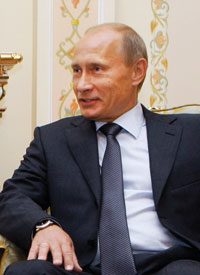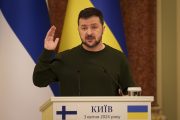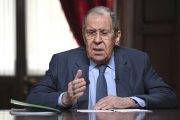
Two critically important (and crucially intertwined) events that concern our national security — and our survival — occurred during the week of July 5-11, but you almost certainly didn’t hear a peep or read a word about either one of them. Apparently, our political and media elites think it’s not important for us to know about such things.
Here is the first event to which I refer, as presented by the Sino-Soviet “news” agencies.
“Russian troops are getting aboard a Chinese train Wednesday to take part in joint anti-terrorist exercises Peace Mission 2009, that will be held on the Chinese territory,” the Russian agency ITAR-TASS reported on July 8, 2009. In addition to a Russian motorized rifle battalion and an airborne company, the Chinese train also transported 150 Russian tanks, armored personnel carriers, and trucks. Some 20 Russian aircraft — bombers, fighter jets, transports, and helicopters — were flown to the exercise site in northeast China.
The headline of a July 12 story for Communist China’s Xinhuanet news agency reported, “More Russian military forces arrive in China for joint anti-terror exercise.” The massive five-day war games, held July 22-26 in the Shenyang Military Area Command, are a repeat of similar China-Russia joint military exercises in 2005 and 2007, which also took place under the name of “Peace Mission.” A shorter two-day joint “anti-terror” drill took place in April of this year. The operation, dubbed Norak-Antiterror 2009, was conducted in Kazakhstan on April 17-18 with units from the armed forces of the Shanghai Cooperation Organization (SCO): Russia, China, Tajikistan, Kazakhstan, and Kyrgyzstan.
These military operations (which have gone virtually unreported in the United States) underscore the extensive and growing military, economic, technological, and political cooperation between Moscow and Beijing over the past decade and a half. They also demolish the supposed wisdom of the prevailing “experts” at the CIA and State Department, who contended that the “Sino-Soviet split” was “permanent,” and that the United States should encourage this perceived split by wooing both communist regimes with diplomatic overtures, aid, and trade.
Four decades of this bipartisan wisdom by U.S. policymakers has resulted in the transfer, virtually, of America’s entire manufacturing base to China and the transformation of Mao’s “People’s Republic” from a weak and hopelessly primitive Third World state into a global economic and military superpower.
The second event to which I referred above took place in Moscow about the same time as the Sino-Russian military operations were being set into motion in China: President Barack Obama and his entourage landed in Russia on July 6 for a three-day state visit. In addition to meeting with Russian President Dmitry Medvedev and Prime Minister Vladimir Putin, Obama met with former President Mikhail Gorbachev and Gennady Zyuganov, chairman of the Russian Communist Party, who said he complimented President Obama on his economic stimulus program. “I said that I had thoroughly studied [Obama’s] anti-crisis program, that I liked it, as well as that it is socially oriented and primarily aimed at supporting poor people and enhancing the state’s role,” Zyuganov told Interfax, a Russian news agency. “I said all this to President Obama.”
These two events illustrate two fatal fallacies that underlie our decades of suicidal policies vis-à-vis Russia and China, as implemented by both Democratic and Republican administrations.
“Splits” and Scissors
Belief in a strategically exploitable Sino-Soviet split became not only the foundation for U.S. policy toward Communist China, but also provided the rationale for our relations with all communist regimes. If the world communist monolith was fragmenting owing to internal fissiparous forces, the argument ran (and continues to run today), then why not speed the process? Thus we saw policies aimed at courting communist regimes in Yugoslavia, Romania, Poland, Hungary, Czechoslovakia, and elsewhere, with the announced aim of wooing them from the Soviet orbit.
From the strategic “split” doctrine came a corollary: besides working to create cleavages between communist countries, why not also work to create cleavages within communist countries by supporting “liberal” and “democratic” political factions among the ruling communist elites?
Of course, that is what the bipartisan strategists such as Henry Kissinger and Zbigniew Brzezinski claim to have done. Communism has collapsed, they say; the former Soviet Union has fragmented, with the former Warsaw Pact nations joining the European Union and NATO, and the Communist Party of the Soviet Union (CPSU) no longer holds sway in Russia. Yes, China is still ruled by the Communist Party of China (CPC), but the “hardline” Marxists in Beijing have lost out to the regime’s pragmatic capitalists, goes the argument.
Unfortunately, the delusional acceptance of these fatal fallacies has achieved the exact opposite of the benefits promised by the “wise men” of foreign affairs. The supposed permanence of the Sino-Soviet split — as noted above, and as could be demonstrated by hundreds more examples — has proven as evanescent as a popsicle in Hades. The new Sino-Soviet axis, thanks to our aid, is far more dangerous now than ever it was during the Cold War.
As far as Russia goes, even many of the erstwhile enthusiasts of the so-called sea-change events of 1989-1991 have been forced to admit in recent years that Vladimir Putin has, in many ways, reinstated the Soviet model of dictatorship. In fact, by 2006 much of the western media had finally awakened to the reality that KGB veteran Putin had stacked the top levels of the Russian government with comrades from the KGB (and its successor, renamed the FSB) to the tune of 80 percent — a higher percentage than had ever been seen in Soviet history. The iron fist is now showing through the velvet glove in ways that were predictable, and were indeed predicted.
When the delusions of the Sino-Soviet split and “democratization” were being sold to the American people and U.S. policymakers a generation ago, there were many who soundly warned against accepting such dangerous deceptions. The most cogent and authoritative analysis exposing the looming danger came from KGB defector Anatoliy Golitsyn. For the past nearly 50 years he seems to have been destined to experience the agony of Cassandra, who in vain warned her disbelieving countrymen against bringing the Greeks’ gift horse inside Troy’s impregnable walls. In a series of memoranda to the CIA, which were later published as two books — New Lies for Old (1984) and The Perestroika Deception (1995, U.S. edition) — Golitsyn provided a remarkably detailed exposé and penetrating analysis that is probably without parallel in human history.
Over the past 90 years, there have been many defectors (both genuine and false) from communist countries, some of whom have provided us with very valuable information and insights. What makes Golitsyn so unique? Golitsyn was a member of the super-secret “inner” KGB — Department D — which planned long-range, strategic disinformation. Other members of the “outer” KGB did not even know of Department D’s existence. It was a crucial creation engineered during the 1959 reorganization of Soviet intelligence by KGB Chairman Alexander Shelepin. Shelepin and the top Soviet leaders determined to undo much of the damage caused by the recently deceased Soviet dictator Josef Stalin, whose paranoia and bloody purges had devastated not only the USSR but the entire global communist system. The KGB would be redirected away from Stalin’s ham-fisted use of the agency primarily for espionage and brutal police-state oppression, into Lenin’s conception of the “Cheka” (NKVD, predecessor of the KGB) as an instrument of strategic deception that would manipulate and control the Soviet Union’s enemies (the United States and the West) by manipulating and controlling the enemy’s perceptions of geo-strategic realities. Shelepin and the Kremlin strategists set out to recreate and test two of Lenin’s most successful strategic deceptions of the 1920s: the New Economic Policy (NEP) and the “Trust.”
Lenin’s Models
Under Lenin’s NEP, limited private enterprise was allowed. This was heresy to communists, of course, but Lenin the pragmatist explained that this was just a temporary step backwards in order to gain strength for the next steps forward in the socialist revolution. The NEP was necessary both to provide the Russian people with incentives to produce and to lure western capital to the Soviet Union. It worked: Ford Motor, DuPont, General Electric, U.S. Steel, and other western companies flocked to Russia, providing the essential wherewithal and technical assistance needed to reindustrialize the Bolshevik regime. When the Kremlin strategists determined that the NEP had finished its usefulness, they shut it down, renationalized all private enterprise and reinstituted the harsh Bolshevik program. The NEP deception would be repeated again (and again) to win further western concessions and aid under new labels: “peaceful co-existence,” “détente,” “glasnost,” and “perestroika.”
Lenin’s “Trust” was the forerunner to the KGB’s fake revolutions and dissident movements that would be unleashed later in the USSR and the Warsaw Pact countries. The Trust, supposedly, was a powerful, secret anti-communist group within Russia that had widespread support among the people and even among leading officials. The Trust carried out spectacular raids and guerrilla activities throughout the USSR and convinced western intelligence agencies to support it. But after several years of this elaborate charade, the Trust was revealed to have been purely an invention of the Cheka, and is the case study par excellence of what the KGB terms the “scissors strategy.”
The term derives from the application of the Marxist-Leninist dialectic methodology, which allows communists to achieve victory by creating phony struggles in which they control both sides. The unwitting adversary is lured into making alliance with the ersatz “dissidents,” “liberals,” or “democrats,” only to be trapped and cut in half by two sides he thinks are opposed to one another. Through its adroit use of the Trust, the Cheka manipulated western government policies regarding the Soviet Union and lured many true Russian anti-communists into the open, so they could be arrested, tortured, imprisoned, and executed.
According to Golitsyn, the Kremlin strategists used the newly reorganized KGB (of which he was a key “inner” member) to launch a succession of Trust and NEP deceptions that would be part of a decades-long process to implement “a strategy for ‘restructuring’ the whole world.” In The Perestroika Deception, Golitsyn argues:
The Soviets are not striving for genuine, lasting accommodation with the Western democracies but for the final world victory of Communism…. They intend to exploit the same illusion to induce the Americans to adopt their own ‘restructuring’ and convergence of the Soviet and American systems using to this end the fear of nuclear conflict.
According to Golitsyn, Gorbachev (and his predecessors and successors) is pursuing an incredibly intricate “global strategy … to lure the United States into convergence and World Government.”
The charge would be too fantastic even to contemplate except for two things: 1) Anatoliy Golitsyn has correctly called the shots — often years in advance — on some of the most astounding geo-political events of our age; and, 2) The verifiable facts on the ground more accurately fit his analysis than all the wishful thinking and deceit peddled by the acclaimed (but always colossally wrong) “experts” of the disinformation axis in Washington and Moscow.
Concerning the first point, we should note that author Mark Riebling (Wedge: The Secret War Between the FBI and CIA, Knopf, 1994) conducted a systematic analysis of Golitsyn’s book New Lies for Old, and found that out of a total of 148 falsifiable predictions, 139 had been verified by 1993, giving Golitsyn an accuracy rating of 94 percent. And his predictions were not small matters; they included details of the forthcoming fake liberalizations throughout Eastern Europe, followed by similar developments in the Soviet Union. He predicted the removal of the Berlin Wall, the unification of Germany, and the admittance of former communist Warsaw Pact nations into the European Union.
Facts on the Ground
Concerning the second point, the facts today argue more strongly than ever that Golitsyn’s analysis was — and is — correct. Among the literally hundreds of examples that could be cited that have been barely mentioned, completely ignored, or misreported in the western media:
• Contrary to the claims of the “end of communism” school of thought, “former” KGB and Communist Party leaders continue to dominate the former USSR and Warsaw Pact countries, occupying the crucial centers of power: the military, the security services and police, the main political parties, the media, the financial institutions, the educational institutions, virtually all economic sectors, and all branches of government.
• This overwhelming dominance by unrepentant and unchastened communists accounts for the fact that “lustration” laws aimed at ferreting out those responsible for murder, torture, imprisonment, and oppression on a scale never previously seen in history have been almost completely thwarted. Nothing remotely comparable to the post-World War II de-nazification of Germany has occurred; only a handful of communists have been prosecuted.
• Russian Orthodox Christians continue to suffer horrible betrayal by their KGB-controlled clergy, who fully support Putin and the Kremlin leadership. The death in 2008 of Patriarch Alexy II, head of the Russian Orthodox Church (and a dedicated KGB agent since 1958), showed the continuity of the Soviet state. All three replacement candidates were identified KGB operatives, including Archbishop Kirill I, who was chosen to be the new patriarch.
• In Russia, Putin has been able to use his KGB-FSB siloviki to harass, intimidate, kidnap, torture, imprison, and assassinate his opponents, whether journalists, politicians, businessmen, or activists.
• The European Union is being drawn ever tighter into Moscow’s noose of energy dependency through the Russian state oil and gas mega-corporations — Rosneft, Gazprom, Nord Stream — run by Putin’s “former” KGB-FSB comrades.
• The United States is traveling the same path, with the KGB-run LUKoil taking over more than 2,000 gas stations on our eastern seaboard that formerly were owned and operated by Mobil and Getty Oil.
• KGB operatives who have been exposed in top positions of the “post-Soviet” European countries include Polish Prime Minister Jozef Oleksy; Polish President Aleksander Kwasniewski; Lithuanian Prime Minister Antanas Valionis; Lithuania’s head of State Security, Arvydas Pocius; Hungarian Finance Minister and Prime Minister Péter Medgyessy; Hungarian Prime Minister Gyula Horn; and Bulgarian President Georgi Sedefchov Parvanov.
• Hungarian KGB agent Sandor Laborc was made head of Hungary’s secret services and then intelligence chief for NATO, where he was put in charge of the West’s most sensitive secrets. Estonian Defense Ministry official Herman Simm was recently exposed as an FSB asset who has passed many NATO secrets to Moscow.
• While pretending for decades to oppose the European Union, the KGB’s most trusted moles played major roles in building the “Europe from the Urals to the Atlantic.” Two key French KGB agents on the EU project were Alexandre Kojeve and Charles Hernu. Kojeve wrote that a world socialist state could be realized through the gradual expansion of European integration across the globe.
• Lifelong Marxist-Leninist Mikhail Gorbachev has approvingly described the EU as “the new European Soviet.” Russian dissident Vladimir Bukovsky has disapprovingly warned that “having just buried one monster, the Soviet Union, another remarkably similar one, the European Union, is being built…. The EU is the old Soviet model, presented in Western guise.”
• Western politicians and intellectuals may insist that Beijing has abandoned Mao’s communist ideology, but Hu Jintao, Chinese president and general secretary of the Communist Party of China (CPC), and other top CPC officials regularly affirm their commitment to Marxism-Leninism and point to market “reforms” as a temporary expedient along the lines of Lenin’s NEP.
• Before he was murdered, former KGB-FSB Lt. Col. Alexander Litvinenko revealed that al-Qaeda’s No. 2 man, Ayman al-Zawihiri, was an operative of the FSB, as are many of the other so-called “Islamic” terrorists. “The bloodiest terrorists of the world were or are agents of the KGB-FSB,” he said.
Photo: AP Images



